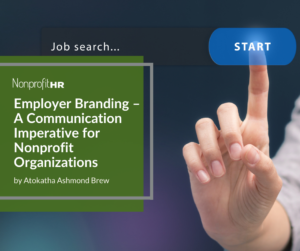WTOP: 5 ways nonprofits can…
Many social impact organizations we find are so focused on mission and building up operational structures that culture becomes an afterthought. But we’re here to tell you that shared organizational values, as embodied by culture, influence everything else in an organization! It’s imperative to position your organization’s shared values as the foundation of your organizational structure in order to effectively pull them into everything you do.
How to Select Shared Values
If your organization is setting out to identify shared values for the first time, understand that there is no wrong answer. Start by looking at the definition of shared values. They are common beliefs and traits of employees that unite them. Shared values guide the actions and decisions of an organization.
Next, take a look at how your staff and organization currently operates and how it supports your mission. For example, your staff may work very collaboratively. If it’s something that every person in the organization, whether in accounting or on the front-lines, can align with in the work they do to support your mission, then consider adding “collaboration” or “teamwork” as a shared value.
How to Assess Embodiment of Shared Values
When it comes to culture, so many project management basics are lost. Approach assessing and establishing your organizational values like a project that requires management. You wouldn’t start an accounting audit without looking at what you need and what’s missing. It should be the same for an organizational values-based project. This means that if your organization already has shared values in place, be sure not to start the journey promoting them before you’ve reflected on the current state of how they’re understood within your organization.
The first step in this assessment process is to ask the question of employees: What are our values? Gauge if they’re able to communicate that back to you. If they’re not, you have your starting point. For example, it may mean you need to be more transparent at communicating those values. Employees can’t promote the values if they don’t know what the values are.
Once you first gain an understanding of the current state among the employee base, then, make sure values are aligned with the work you’re doing and communities you are serving, at present day. For example, some organizations who established values five years ago roll over those same value concepts year to year. Yet since then, they’ve shifted their mission or strategic plan a bit and they haven’t adjusted their values to align. This is when reevaluation is critical to ensure continued mission alignment.
However, let’s say you have five values. When you’re going back to determine if/how to adjust them to better align with your present-day practices, it doesn’t necessarily mean you need to shift all five of them. Perhaps only one of those values no longer applies, as a result of the changing employee base or work, etc. Perhaps you aim to maintain the same concept, but you need to refresh the word you use. For example, instead of “teamwork,” you might adjust it to “mutual respect.” The concept is the same, but you’ve positioned it differently as a reflection of the way your organization now operates.
In order to consider this assessment process complete, you need to have an understanding of your employees current state and your shared values up-to-date and aligned. Then, you can build a strategic plan of how to promote them and reimplement them into the organization.
How to Promote Shared Values in the Employee Lifecycle
Within talent acquisition, promoting shared values is rooted in the organization’s branding. Organizational culture is part of your brand and should be transparently displayed for prospective talent. Ask: In your job postings and employer profiles, are you speaking to what your organizational values are? Does every job description state your values, either in the heading or in a strategic blurb?
When you transparently position your organization’s shared values, it enables external candidates to understand more completely how they align with the organization and what is expected of them. A new hire who comes on board will then be excited to participate and contribute to not only the role, but also the culture.
In the next phase of the employee lifecycle, think through a strategy beyond the large meetings where organization-wide topics are discussed. At an all-staff meeting, the motivation to connect is present, and discussing shared values amplifies that connection. Each employee serves as a communication point to talk about them. However, the real test comes three or four months after those big check-ins. Creating and implementing a communication strategy will be incredibly beneficial to keep it at the forefront for staff. What should be outlined in that strategy is how the organization will establish a cadence.
Aside from annual events, which are low-hanging fruit, consider opportunities to facilitate monthly refreshers on each of your values. Ensure you’re broadcasting it in shared spaces or that they are in your team chat or weekly newsletter. At Nonprofit HR, for example, we use TinyPulse (Limeade Listening) that also allows staff to “cheers” their colleagues based on our shared values.
Additionally, to maintain and grow staff, ensure talent development plans don’t simply speak to the next level of skills and expertise, but also speak to how they exhibit the shared values at a more advanced level. To support this, reinforce shared values in continuous feedback conversations. This will encourage staff to engage and embody these values through their work as they grow in your organization. Consider the below example.
Shared Value: Team and collaboration
Entry-level: I am vocal in my meetings.
Mid-level: I propose different thought partnering sessions.
Senior level: I am facilitating thought partnering sessions and creating the time and space for collaboration.
The best way to maintain staff and leadership accountability to shared values is through upward feedback. As a leadership team member, those expectations should be established from the start. When it comes to staff, sometimes employees hesitate to give upward feedback in general, but especially when it comes to values. However, it is essential that employees feel encouraged and comfortable to bring it up to their supervisors. Just as employees give feedback on how they work best, they should give feedback regarding organizational culture and how they can best exhibit the organization’s values in their work.
How to Spot Misalignment Between Shared Values and Employee Behaviors
Low morale and conflict: The easiest way to spot a misalignment between the organization’s shared values and what employees are exhibiting is if there’s low morale or peer-to-peer conflict in your organization. Consider: Why is the morale low? Why are these two employees complaining about each other? Are they exhibiting, for example, the shared value of “mutual respect”? When there’s low morale, it’s easy to tell that there’s a shift because you’ll see conflict. Maybe the employees involved don’t even remember that it is a shared value. This means a breakdown in the communication strategy or process of those values and it resulted in a conflict that now needs to be resolved. Even if there isn’t conflict, consider that while staff may be getting the work done, there’s always an opportunity to assess whether it’s getting done in a way that represents the organization (i.e. in accordance with those shared values).
Leadership not being a champion: When you see that leadership is not being a champion of organizational culture and shared values, it likely means they’ve lost sight of its importance. They may be talking about productivity and profitability, but there’s no mention of how they are championing values quarter to quarter or how they’re aligning strategic goals with shared values — that means there is misalignment.
If that is the case, the onus is on the leadership of the organization to bring all the leaders back to the table and say, “I’m holding you accountable to check boxes in terms of programs and operations, but I’m also holding you accountable to champion these values. Come back to the table each month and tell me how you’re a champion of a particular value that we hold.” A key outcome of that championship is that then your employees see the importance of it. Rather than being something that is said in one meeting one time, employees are seeing it modeled and talked about, which will then become the standard in their work too.
Feedback from exit interviews: At the end of the employee lifecycle, be sure to include questions around values in the exit interview and review that feedback to identify areas of opportunity regarding organizational culture.
How to Uphold Shared Values as an Organizational Priority
As with most organization-wide initiatives, having executive buy-in is indispensable. If you have buy-in, even from board members, it’s much easier for a leadership team to really promote values and the importance of organizational culture. Why? Because the organization and everyone in it is now being accountable to a board and leadership team.
In addition, I recommend readjusting your framework. Within your operational structure, where are your shared organizational values represented? Rather than having to go back and realign your operations with your values, move shared values to the top of the list. It will save you from having to rework other areas because your culture serves as the foundation for all other areas of organization. By not taking the time upfront, you’re going to have much more work down the line to go back and readjust other components of organization. Think of your shared values as your mold and work backwards from there to guarantee you’re using those values to connect your people, drive your culture and amplify mission impact.
How to Overcome Potential Roadblocks
The number one reason organizations don’t prioritize this is because they don’t tie a strong culture to profitability. They may consider it just as the way things are and that it doesn’t influence the grants they receive or the funds they raise.
However, break down how you measure profitability in different areas, you may have a shared value of “excellence” and find profitability in how fast someone can get their work done. If someone wants to exhibit greater excellence, they will work with a higher standard of quality and quantity. That directly ties to profitability.
Also, when an organization doesn’t have a strong culture of shared values, an employee is less likely to feel a connection to the organization. They don’t feel they are a piece to the puzzle. You’ve lost training and time spent on that person, which is a loss of your return on interest. Organization’s still don’t see it directly connected to their bottom line, even though it’s been proven again and again that a strong culture leads to increased productivity and profitability.
Additionally, especially in the last few years, there’s fatigue. There’s fatigue even with the work people are doing every day. We’ve had so much change that people are tired and I hear leadership teams saying that they don’t want to give folks more work. But if you don’t invest in your culture, then your staff are likely to feel disconnected from your organization. If you don’t promote shared organizational values, you may not see work at the level of quality that you expect it to be done. It is about realigning and reiterating that it is a priority and it directly impacts driving your mission forward.
Nonprofit HR Knowledge & Research

































